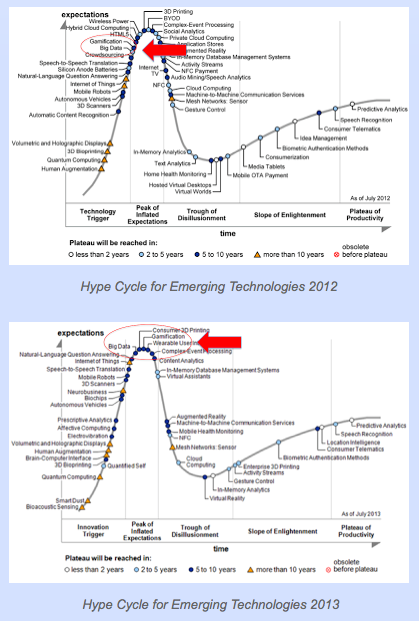The debate about what the definition for gamification should be is far from being over. After the definition from Brian Burke and Gartner (see A Brief History of Gamification: Part V - The Definitions (Again) ), more definitions saw the light of day:
Andrzej Marczewski publish in his blog the post Defining gamification – what do people really think? where he presents an "average definition" for gamification: creating more game-like experiences in non game contexts. He points that this definition "does not include anything about why or how, just what it is". His proposal results from an average of a list of other definitions (some from gamification gurus), looking at the most common concepts present. He concludes by saying "we are all trying to make more engaging experiences for people using ideas that games have been using forever".
A different approach is proposed by Rajat Paharia, the founder of Bunchball, in A New Day for Gamification, or Is It? For him, gamification is motivating people through data. He comments on Burke's definition stressing that it could be enhanced with less emphasis on game language, avoiding the use of terms like "players". For Paharia, gamification is not about games and not about play. He even quotes Brian Burke about gamification not being about fun. In short, Rajat Paharia's view of gamification is very enterprise and business related and gamification is more than that.
Finally, and recently, Kevin Werbach, the man behind the well-known MOOC on gamification, has a paper ((Re)Defining Gamification: A Process Approach) discussing and explaining his new definition: the process of making activities more game-like. The main change here is the notion of gamification as a process. In Werbach's view, his definition "creates a better fit between academic and practitioner perspectives". Most definitions rely on the use of game elements, in what he calls the elemental definitions, Using game elements in non-game contexts is not the same as transforming that context into something more game-like. To do that, a process is needed. The process can transform the activities to be more or less game-like. Therefore, the frontier between gamified and non-gamified settings is wider. He points that in education, the fact that a point system is used (the grades), it is not possible to say that school activities (e.g. examinations) are gamified. At least, it means that education is a good non-game context that can be gamified as others mentioned (e.g. Lee and Hammer's Gamification in Education: What, How, Why Bother?). Werbach's definition is also aligned with the "average" definition from Marczewski.
Could the new Kevin Werbach's definition replace the widely used definition from Deterding et al., the use of game design elements in non-game contexts?
Some final remarks about what is gamification:
- It is not the same as games, but it is about games. If it is not about games, why call it gamification in the first place? If it is about games, the users of gamified applications can be called players, to highlight the idea, but this is probably not very important.
- Is is not clearly just about digital engagement. Is is about engagement, regardless of the medium, with a digital or non-digital approach. But digital tools can be very helpful.
- It is not about play, but it must feel as play, and it must be fun (how to define fun, anyway?). The importance of fun is the reason of the concept's name, the fun part of games, that lead to gamification.
- Data plays a central role in a gamification process because it drives the relation between the gamified application and the players. Again, digital tools can be very helpful.
- And it has a clear purpose: motivate people to change their behaviors and feelings about something that is not a game and is perceived as boring, unchallenging or without value. Making the thing (some activity in a non-game context) more game-like, by using what games have that can be used outside games, can engage people and motivate them to act properly regarding the thing's objectives.
All these definitions make their contributions: Burke with the focus on motivation and engagement as the purpose of gamification, Paharia with the focus on data and Werbach and Marczewski with the focus on the process of creating game-like experiences.
See also these other posts about the history of gamification:
A Brief History of Gamification: Part I - The Origin
A Brief History of Gamification: Part II - The Name
A Brief History of Gamification: Part III - The Definitions
A Brief History of Gamification: Part IV - The Evolution
A Brief History of Gamification: Part V - The Definitions (Again)
A Brief History of Gamification: Part VI - The Predictions
A Brief History of Gamification: Part I - The Origin
A Brief History of Gamification: Part II - The Name
A Brief History of Gamification: Part III - The Definitions
A Brief History of Gamification: Part IV - The Evolution
A Brief History of Gamification: Part V - The Definitions (Again)
A Brief History of Gamification: Part VI - The Predictions






